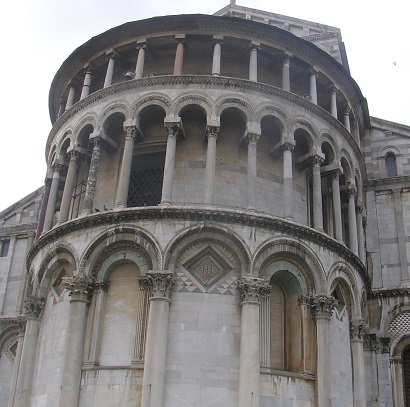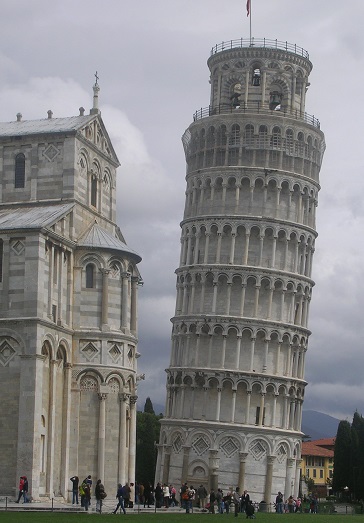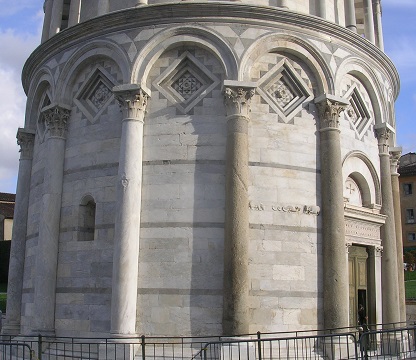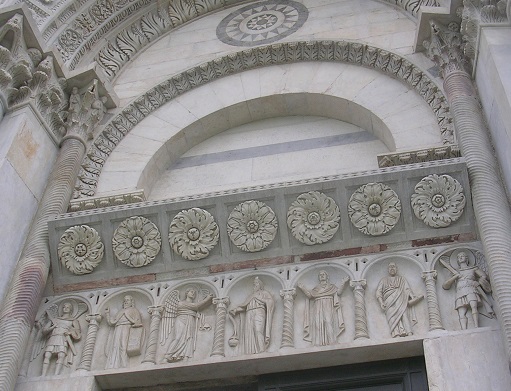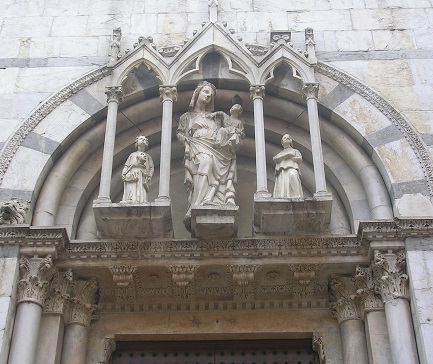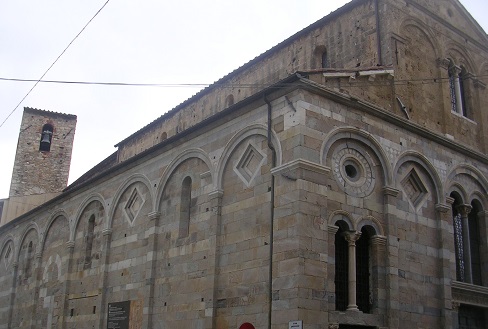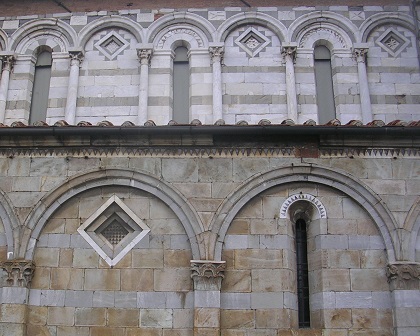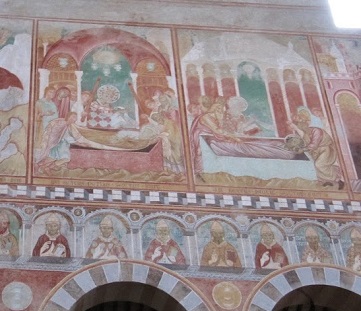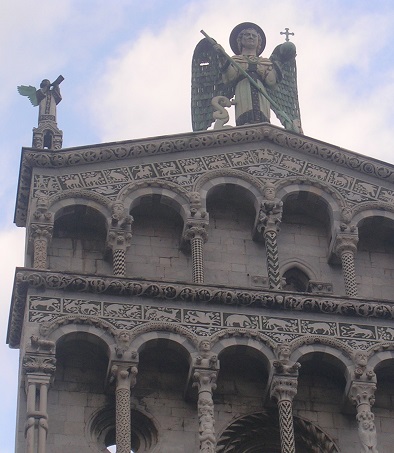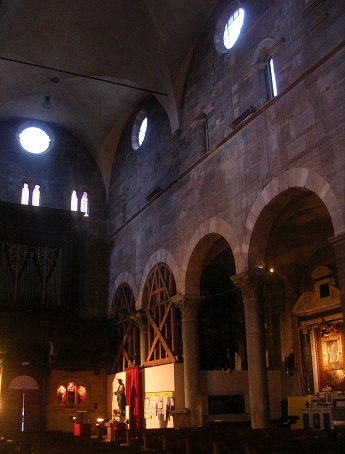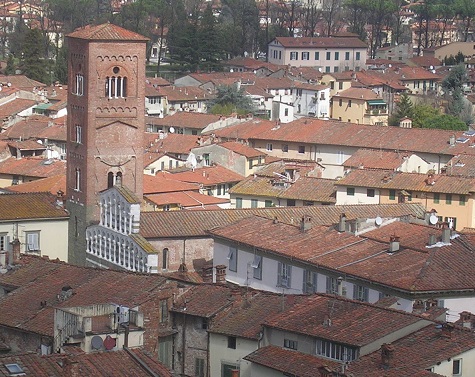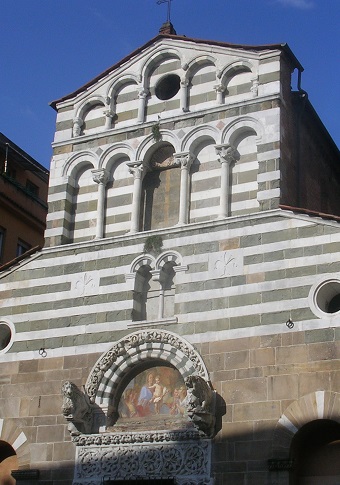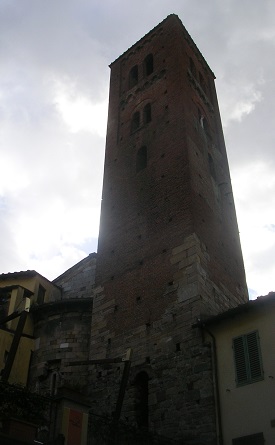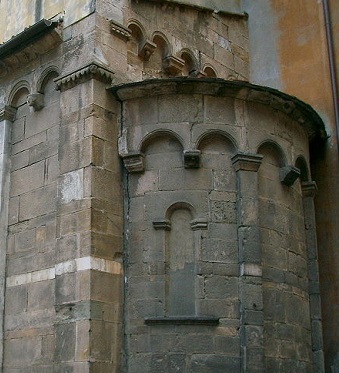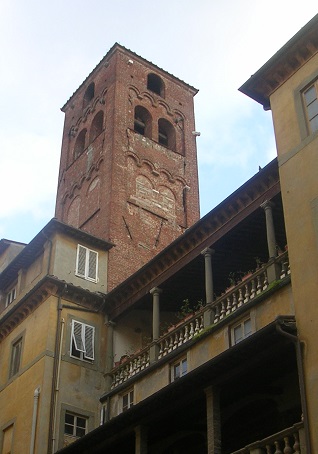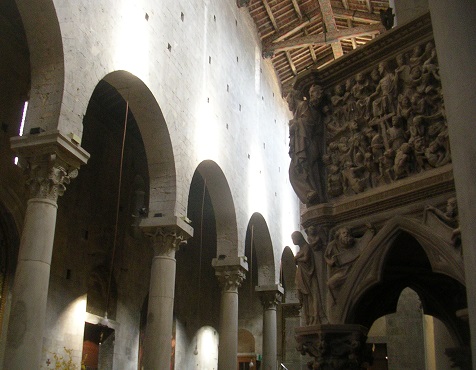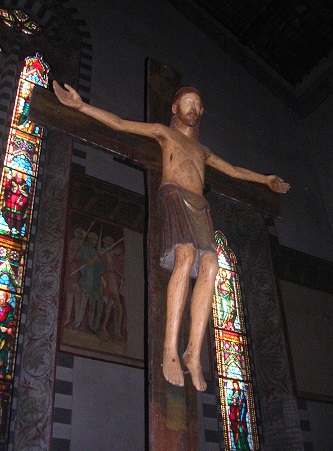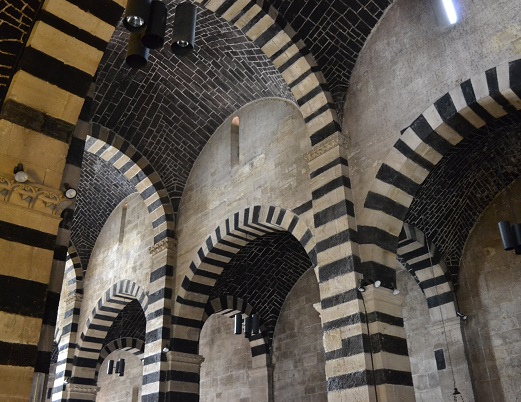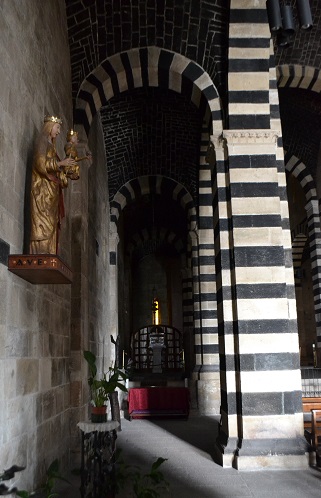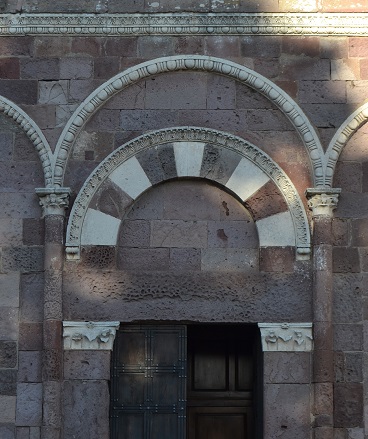|
|
Pisan
Romanesque Art
Pisa,
Lucca & Pistoia
This page provides
an overview of the romanesque architecture and art originating from
the Republic of Pisa in northern Tuscany. The original pisan romanesque
style is characterized by its basilical churches with magnificent
arcaded facades and important portal and pulpit sculpture. The style
emerged in the 11th century, developed during the 12th century and
transformed into gothic up to the 14th century. This page presents
the famous romanesque cathedral complex of Pisa as well as the romanesque
churches of the cities of Pisa, Lucca and Pistoia and the island
of Sardinia.
Introduction
Piazza dei Miracoli
Pisa churches
Lucca
churches
Pistoia
churches
Sardinia
churches
 Introduction
Introduction
The importance of the pisan art style historically
relates closely to the prosperity of the Republic of Pisa.
This independent state was founded in the 10th century and grew
during the 11th century to become a commercial and naval center
dominating the Mediterranean. This mighty maritime nation, regularly
competing with Genoa, captured Sardinia in 1016 and Corsica in 1051-52.
The pope elevated the diocese of Pisa to the rank of metropolitan
archdiocese in 1092. The Pisan fleet participated in the First Crusade
and the siege of Jerusalem in 1099. Pisa then had several possessions
and privileges across the Mediterranean and the Byzantine Empire,
which brought back an oriental influence. Ultimately, the Republic
of Pisa was destroyed in the Battle of Meloria against Genoa in
1284 and sold to Florence in 1402.
The pisan style, which lasted approximately from the mid 11th century
to the 13th century, is an original romanesque style with oriental
influences.  The
exteriors of the churches, in white marble, are extensively decorated
with arcades on columns, polychrome and geometrical motifs. The
decoration is concentrated on the apses and on the facades, which
present several layers of arcades on columns creating magnificent
visual effects as well as portals with lintel sculptures. High campaniles
with several levels of openings are situated next to the churches.
The interiors of the churches are sober, and the naves on columns
are still very similar to the early medieval basilicas of Rome.
Interior decoration is quite abundant and includes capitals, crucifixes,
carved doors, mosaics, paintings and some important pulpits and
baptismal fonts. The 13th century school of the Pisano brothers
has left some very fines sculptures and famous pulpits. The
exteriors of the churches, in white marble, are extensively decorated
with arcades on columns, polychrome and geometrical motifs. The
decoration is concentrated on the apses and on the facades, which
present several layers of arcades on columns creating magnificent
visual effects as well as portals with lintel sculptures. High campaniles
with several levels of openings are situated next to the churches.
The interiors of the churches are sober, and the naves on columns
are still very similar to the early medieval basilicas of Rome.
Interior decoration is quite abundant and includes capitals, crucifixes,
carved doors, mosaics, paintings and some important pulpits and
baptismal fonts. The 13th century school of the Pisano brothers
has left some very fines sculptures and famous pulpits.
The Piazza del Duomo or Piazza dei Miracoli,
centre of the Pisa diocese situated in the north of the town, houses
some of the worlds finest medieval monuments. Construction on the
cathedral of Pisa, the archetype of the pisan school of art, began
in 1063. The mighty construction, which lasted into the 12th century,
was led by Buscheto and Rainaldo. The floor plan consists of five
naves counting 10 bays, a large transept with cupola, aisles and
apses, and a choir with apse. The elevation of the interior counts
three levels with beautiful galleries and a wooden ceiling. Decoration
includes the bronze gates by Bonnano Pisano and the apse mosaics
by Cimabue. From 1153 onwards, Diotisalvi built the Battistero situated
in front of the cathedral. This rotunda on two levels is an architectural
masterpiece and houses important works of art. The pulpit is the
work of Nicola Pisano and older than the one in the cathedral made
by his son Giovanni, both decorated by abundant sculptures in gothic
style. The famous leaning tower, a beautiful romanesque campanile
on a circular floor plan, was started in 1173. Work on the complex
continued until the 15th century, with the completion of the cathedral,
the construction of the gothic Camposanto and the completion of
many fine works of art. Two museums present art works originating
from the cathedral complex.
The historical cities of Pisa, Lucca and Pistoia preserve a variety
of churches that are great examples of the pisan school. The three
main churches of Lucca, the Duomo, S. Frediano
and S. Michele, present great facades, campaniles and sculptures.
Some more beautiful facades can be found at S. Paolo a Ripa d'Arno
in Pisa and S. Maria Forisportam and S. Pietro Somaldi in Lucca.
The Duomo and the main churches in Pistoia are
columned basilicas with facades, carved lintels and some interesting
pulpits. Some original works are the octogonal templar church of
S. Sepolcro and the narthex of S. Zeno, both in Pisa, the basilica
of S. Pietro a Grado, and the beautiful lateral wall of S. Giovanni
Fuorcivitas in Pistoia. Development of the pisan style has left
beautiful romano-gothic facades at S. Michele in Borgo and S. Caterina
in Pisa. The old town of Lucca also has some beautiful medieval
palaces and towers.
This page provides an overview of the monuments in Pisa, Lucca and
Pistoia. The most important monuments
are marked by a star  .
Some other examples of the pisan style in the Toscana region
can be found in Massa Marittima, Prato, Peccioli, Cascina and Carrara.
The romanesque churches of Corsica and Sardinia, which also belonged
to the Republic of Pisa, also present a clear pisan influence. A
section of the page is dedicated to some churches in northern Sardinia,
which show a clear pisan style next to influences from lombard and
french styles. The largest and oldest church is S. Gavino in Porto
Torres, a long basilica church built with roman columns, featuring
two opposing apses. The polychrome facades of S. Trinita di Saccargia
and S. Pietro di Sorres are the best examples of the pisan splendor,
while some orgininal items are the frescos of byzantine descent
in Saccargia and the double-layered narthex in Bisarcio which is
more common in France. .
Some other examples of the pisan style in the Toscana region
can be found in Massa Marittima, Prato, Peccioli, Cascina and Carrara.
The romanesque churches of Corsica and Sardinia, which also belonged
to the Republic of Pisa, also present a clear pisan influence. A
section of the page is dedicated to some churches in northern Sardinia,
which show a clear pisan style next to influences from lombard and
french styles. The largest and oldest church is S. Gavino in Porto
Torres, a long basilica church built with roman columns, featuring
two opposing apses. The polychrome facades of S. Trinita di Saccargia
and S. Pietro di Sorres are the best examples of the pisan splendor,
while some orgininal items are the frescos of byzantine descent
in Saccargia and the double-layered narthex in Bisarcio which is
more common in France.
 Piazza dei Miracoli (Piazza
del Duomo)
Piazza dei Miracoli (Piazza
del Duomo)
DUOMO S. MARIA ASSUNTA 
Basilica (1063-12th-13th-14th), transept, mosaics (13th), pulpit
(1302), doors (12th).
TORRE PENDENTE (CAMPANILE) 
Campanile (1173-1350).
BATTISTERO S. GIOVANNI 
Rotunda (1153-13th-14th), cupola, portals, pulpit (1260), font (1246).
CAMPOSANTO
Cloisters (1277-15th), sarcophagi, paintings (14th).
MUSEO OPERA DELL DUOMO & MUSEO DELLE SINOPIE
Sculptures (11th-14th), statues, paintings (13th-15th).
 Pisa churches
Pisa churches
S. PAOLO A RIPA D'ARNO (DUOMO VECCHIO)

Basilica (mid 12th), facade, capitals, S.Agatha chapel (11th).
S. SEPOLCRO 
Rotunda (12th), pyramid, cupola, portals.
S. MICHELE IN BORGO
Basilica (12th-14th), facade, capitals.
S. SISTO
Basilica (11th-12th), facade, capitals.
S. ZENO
Basilica (11th-12th), narthex.
S. PIETRO IN VINCULIS (SAN PIERINO)
Basilica (11th-12th), facade, capitals.
S. MICHELE DEGLI SCALZI
Basilica (12th), facade, capitals, crucifix (13th).
S. NICOLA
Facade (12th), campanile.
S. FREDIANO
Basilica (11th), facade, capitals, crucifix (12th).
S. MATTEO (MUSEO NAZIONALE)
Nave (11th-13th), sculptures, paintings.
S. PAOLO ALL'ORTO
Facade (12th), portals.
S. ANDREA FORISPORTAM
Basilica (12th), facade, capitals.
S. CATERINA (D'ALESSANDRIA)
Facade (13th-14th), campanile, statues.
S. PIETRO A GRADO (S. PIETRO APOSTOLO) 
Basilica (10th-12th), apses, campanile, capitals, paintings (13th-14th).
MORE CHURCHES : S. CECILIA, S. MICHELE ARCANGELO, S. EUFRASIA,
SS. JACOPO E FILIPPO, S. CRISTINA
Romanesque elements.
 Lucca churches
Lucca churches
DUOMO S. MARTINO 
Basilica (1060-12th-15th), transept, facade, portals, campanile,
apse, statues, crucifix (12th).
S. FREDIANO 
Basilica (1112-12th-13th), facade, portal, mosaic (13th), campanile,
apse, capitals, font (12th), floor (12th), paintings (13th).
S. MICHELE IN FORO 
Basilica (1143-12th), transept, facade, statues, capitals, campanile,
apse, crucifix (12th).
S. MARIA FORISPORTAM (S. MARIA BIANCA) 
Basilica (12th), transept, facade, portals, campanile, apse.
SS. GIOVANNI E REPARATA
Basilica (12th), transept, portal, crypt (5th-6th), battistero (14th).
S. PIETRO SOMALDI
Basilica (12th), facade, portals (13th), campanile (14th).
S. GIUSTO
Facade (12th-13th), portal, apse.
S. CRISTOFORO
Basilica (12th-13th), facade, portal, tower, fresco (13th).
S. ALESSANDRO
Basilica (11th), facade, portal, capitals.
S. SALVATORE
Facade (12th), portals, walls.
S. MARIA CORTEORLANDINI (S. MARIA NERA)
Portal (12th), walls, apse.
SS. SIMONE E GIUDA
Basilica (13th), facade, apse.
S. GIULIA
Facade (13th).
S. ANASTASIO
Facade (13th), portal (12th-13th), nave, apse.
MORE CHURCHES : S. MICHELETTO, S. TOMMASO, S. PONZIANO,
S. ANDREA
Romanesque elements.
CIVIL ARCHITECTURE
Palaces, towers, gates (12th-14th).
MUSEO NAZIONALE DI VILLA GUINIGI
Sculptures (12th), capitals, statues, crucifixes (12th-13th).
 Pistoia churches
Pistoia churches
DUOMO S. ZENO 
Basilica (12th-13th), facade, portals, narthex (14th), campanile,
capitals, crypt, crucifix (13th), altar (13th) ; Battistero (14th).
S. ANDREA 
Basilica (12th), facade, portal, capitals, pulpit (1298).
S. BARTOLOMEO IN PANTANO 
Basilica (12th), facade, portal, apse, campanile (13th), pulpit
(13th).
S. GIOVANNI FUORCIVITAS 
Walls (12th), portal, pulpit (12th-13th), crucifix.
S. PIER MAGGIORE
Facade (12th), portals, walls.
S. MICHELE IN CIONCIO
Chapel (12th-13th), facade, portal, apse.
S. PAOLO
Facade (13th), portal, walls (12th).
S. SALVATORE
Facade (13th).
S. MARIA A RIPALTA
Chapel (12th), apse, fresco (13th).
S. MARIA CAVALIERA (S. MARIA MAGGIORE)
Walls (13th), apse.
S. BIAGIO
Facade, portal.
 Sardinia churches
Sardinia churches
PORTO TORRES, S. GAVINO (CATTEDRALE)-

Basilica (1030-1080), apses, portal, capitals, crypt excavations
(4th), sarcophagi.
SACCARGIA, S. TRINITA 
Porch, capitals, facade, nave, transept, campanile, apse, frescos
(late 11th), monastery ruins.
BORUTTA, S. PIETRO DI SORRES (CATTEDRALE) 
Basilica (11th-12th), facade, portal, apse, altar, pulpit (14th),
monastery.
BISARCIO, S. ANTIOCO (CATTEDRALE) 
Basilica (11th-12th), narthex (1170-1190), facade, apse, campanile,
cathedral complex ruins.
ARDARA, S. MARIA DEL REGNO
Basilica, facade, apse, campanile.
TERGU, S. MARIA
Facade (12th-13th), nave, campanile; monastery porch & foundations
(9th-12th).
OLBIA, S. SIMPLICIO
Basilica (11th-12th), facade, apse, capitals.
MORE CHURCHES : ORISTANO, DOLIANOVA, TRATALIAS, ...
List not intended to be complete.
Web links
Pisan Romanesque Art
http://www.itineraromanica.eu/
http://www.stilepisano.it/
http://www.medioevo.org/artemedievale/Pages/Toscana/Toscana.html
http://it.wikipedia.org/wiki/Romanico_pisano
http://www.hvweb.net/en/360photos/tuscany/
Piazza dei Miracoli
http://www.opapisa.it/
http://www.sacred-destinations.com/italy/pisa
http://en.wikipedia.org/wiki/Piazza_dei_Miracoli
Pisa churches
http://www.medioevo.org/artemedievale/Pages/Toscana/Pisa.html
http://www.stilepisano.it/Pisa_facciate_chiese.htm
http://it.wikipedia.org/wiki/Chiese_di_Pisa
Lucca churches
http://www.medioevo.org/artemedievale/Pages/Toscana/Lucca.html
http://www.comune.lucca.it/turismo/chiese_lucca
http://www.sacred-destinations.com/italy/lucca
http://it.wikipedia.org/wiki/Chiese_di_Lucca
Pistoia churches
http://www.medioevo.org/artemedievale/Pages/Toscana/Pistoia.html
http://it.wikipedia.org/wiki/Chiese_di_Pistoia
Sardinia churches
https://it.wikipedia.org/wiki/Architettura_romanica_in_Sardegna
https://www.sardegnaturismo.it/en/ricerca?search_api_views_fulltext=romanesque
Pictures: Eduard, 2008 (Sardinia 2018). For
any comments or additions feel free to contact me.
[top]
[homepage] [contact] |

 The
exteriors of the churches, in white marble, are extensively decorated
with arcades on columns, polychrome and geometrical motifs. The
decoration is concentrated on the apses and on the facades, which
present several layers of arcades on columns creating magnificent
visual effects as well as portals with lintel sculptures. High campaniles
with several levels of openings are situated next to the churches.
The interiors of the churches are sober, and the naves on columns
are still very similar to the early medieval basilicas of
The
exteriors of the churches, in white marble, are extensively decorated
with arcades on columns, polychrome and geometrical motifs. The
decoration is concentrated on the apses and on the facades, which
present several layers of arcades on columns creating magnificent
visual effects as well as portals with lintel sculptures. High campaniles
with several levels of openings are situated next to the churches.
The interiors of the churches are sober, and the naves on columns
are still very similar to the early medieval basilicas of 




